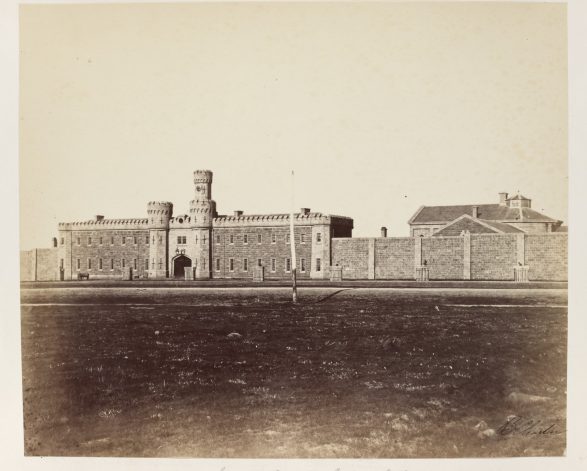Pentridge stopped operating as a prison in 1997 and much of the site has been repurposed for community use, including a cinema and brewery, but the heritage-listed bluestone walls still cast a compelling shadow over Coburg. Self-confessed bushranger nerd Aidan Phelan shone a light on the prison history, and some of its most intriguing inmates from the goldrush era, during a talk held during the Heritage Festival.
‘It all began for Pentridge in the days where Victoria was still the lower portion of the colony of New South Wales,’ Aidan says. ‘Pentridge Stockade was established as a temporary measure in 1850, to combat overcrowding in establishments like the Melbourne Gaol, as well as providing a base of operations for road gangs working on the road to Sydney.’
Early pictures show the stockade covering 43 acres of pastoral country, with a collection of small bluestone buildings housing the officers and their families. When they weren’t working, convicts were held in small portable wooden cells.
‘They looked like cubbies on wheels,’ Aidan says. ‘They would be pulled by a bunch of workhorses to take them closer to where they needed to work.’
The poor security of those early cells was frequently tested when, over the next three years, the Victorian Goldrush led to a boom in the number of convicts held there, from 50 to 200.
One of those early prisoners was Francis Christie, thought to be Australia’s first bushranger. A stockman turned horse stealer, Christie had been sentenced to five years hard labour but, on March 26, 1851, he grabbed a rifle from one of the guards, sparking a mass escape.
‘The law would eventually catch up with Christie and he found himself in jail, on Cockatoo Island in NSW. When he was eventually given his Ticket of Leave, he absconded and became best known as Frank Gardiner,’ Aidan says.
‘Gardiner had many robberies under his belt by the time he undertook his crowning achievement – the robbery of the Orange gold escort at Eugowra. They created a blockade and ambushed two police officers, stealing around £14,000 worth of gold and cash.
‘It was Australia’s biggest ever gold robbery,’ Aidan says. ‘Equivalent to some $4 million today, at a time when the average working man received about £1 per week.’
Over the course of the 1850s and 60s, Pentridge became much more secure with convict labour building the bluestone cells, walls and distinctive gates. The prison earned the nicknamed the ‘Bluestone College’, because of the hard lessons convicts learned there; over a period of 50 years, inmates were subject to the brutal ‘separate and silent system’, which saw them confined to their cells for 23 hours a day.
‘They’re not permitted to talk. The floors were carpeted to muffle the sound of movement and when outside of their cells, prisoners wore hoods to hide their faces. They communicated with their guard using only sign language. This was meant to create an environment without external stimulation in order to encourage introspection…so they would turn to a life of virtue and reform.’
Australia’s most famous bushranger, Ned Kelly, would have had at least a couple of opportunities to reflect on his life choices during repeated stints at Pentridge.
‘Between 1869 and 1870, Ned found himself frequently in trouble with the law,’ Aidan says.
Ned had been released in 1974, after being jailed for horse theft, but was soon in trouble again.
‘He was involved in the wounding of a police constable at his mother’s house, which led to him and his brother Dan, hiding in the bush.’
The Kelly Gang were declared outlaws after they ambushed and murdered three police at Stringybark Creek in 1878. The siege at Glenrowan, where they wore the famous homemade armour, followed.
‘Ned was captured alive, but his companions were killed after his capture. He was sentenced to death for the murder of one of the police officers and was hanged on the 11th of November 1880 at Melbourne Gaol.’
Speaking to a rapt audience at a meeting held by Coburg Historical Society, Aidan reflected on Pentridge’s reinvention as a vibrant community hub, as well as being a place to reconnect with the grim past.
‘It is somewhat amusing to consider how those who did time there all those decades ago would make of it now,’ he says.
Article by Kate Robertson for the 2023 Australian Heritage Festival

 Twitter
Twitter Facebook
Facebook Linkedin
Linkedin Email
Email